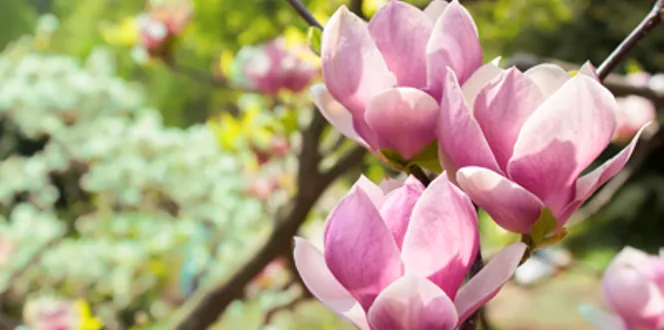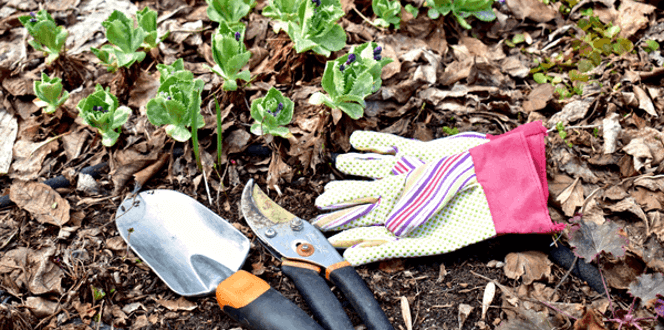Once the snow has cleared, and the days warm up, you begin to get excited about going outside. It is time for warmer days and increased daylight when daffodils start emerging from the ground and new buds on your trees and shrubs start to emerge.
Spring is a time for new growth and new beginnings. It’s so much fun to see your landscape come alive again.
The first few warm days are the best time to assess your landscape status. Old Man Winter leaves quite a mess on your yard, usually after heavy snow and ice events. Early spring is the best time to clean up after his mess.
Let’s learn more about essential tasks you can perform to clean up after winter snow and ice on your property.
6 Ways You Can Clean Up After Winter In Your Landscape
In certain areas of the country, some unexpected winter weather is bound to happen.
And while a winterscape can be pretty in season, we all need a break after a long, cold winter – and that includes your plants, trees, shrubs, and lawn. All that snow and ice accumulation can wreak havoc on your landscape. Assessing the damage and cleaning up what winter left behind can help your yard bounce back.
1. Inspect Your Trees And Shrubs
When snow and ice accumulate on tree and shrub branches, it adds extra weight. Add to that some strong winds, and you have a recipe for cracks, splits, or breaks.
This is particularly true if you have weaker tree branches.
Inspect your trees and shrubs and look for any issues. Prune away dead, dying, or broken branches. If you see some worrisome cracks or breaks you’re not sure how to handle, call a certified professional arborist to assess the damage.
2. Tidy Up By Picking Up Debris
After heavy snow and ice have built up on your trees and shrubs and winds have come through, you’ll likely see some small twigs and branches scattered about your yard, as well as leftover leaves from fall. Even garbage may have blown into your yard and got stuck beneath shrubs and plants.
Spring is a great time to go through your site and pick up this scattered debris, cleaning up what Old Man Winter has left behind.
You might even notice some crushed plant material. Be patient and keep an eye on these plants to make sure they recover through spring.
3. Manage Any Spots You’re Seeing On Your Lawn
Accumulating snow and ice may remain on your lawn for long periods through winter as well as those large piles of snow that have been cleared from sidewalks and driveways.
The first spots you notice may be brown. Once your soil temperature is about 55 degrees Fahrenheit, apply grass seed into these areas after removing dead material and scratching soil surface to encourage germination and fill in holes.
Next, you might see white, tan, or pink spots in your lawn. These blemishes typically indicate snow mold. Rake these areas to break up and dry out the moldy, matted grass to help them recover.
Finally, you might also see brown or crunchy spots in your lawn – possibly at the edges. These can be due to de-icing salt. While rock salt and de-icing products are great for keeping you from slipping and falling as you walk on concrete walkways and driveway, they can also burn when large amounts have been applied near areas of your lawn.
To encourage recovery, rake your lawn gently and wash away salt with water. Adding gypsum to these areas may also help to improve the soil. As the weather warms, you can pull back the salt-damaged grass blades to see if new growth is coming through.
Spring fertilization is also a great task that can help rejuvenate your entire lawn after a long winter.
4. Freshen Up Flower Beds
Everything in your landscape wakes up in spring, including weeds, unfortunately.
As you inspect your flower beds, you may notice weeds cropping up.
Once weeds have been removed, it is a good idea to start using preemergent and post emergent herbicides to keep them managed. Preemergent herbicides act as a shield for weeds that haven’t yet emerged and post emergent herbicdes are used to manage those weeds which were not controlled with preemergent herbicides.
5. Add Mulch To Landscape Beds
Another way to keep weeds at bay is to add a 2- to 3-inch layer of shredded hardwood mulch to your flower beds and tree rings. Remember to spread the mulch evenly and never pile it up too close to tree trunks.
Mulch not only helps suppress weeds, but it also maintains soil temperatures, retains moisture, and insulate plant roots.
6. Check Your Irrigation System
It’s time to wake your irrigation system up after it’s been shut down through winter.
You want to ensure your spray heads are watering tree and plant roots and not driveways or walkways. You also want to make sure you set your watering schedule for long weekly soaks early in the morning, so the water has time to reach plant roots but then evaporates before evening hours as not to encourage disease development.
Hire A Pro To Help You Clean Up After Spring
Feeling overwhelmed by all the things on your spring to-do list?
Don’t let spring cleanup stress you out. Hire a certified local arborist to help. They can perform a thorough inspection of your trees, looking for signs of damage, as well as disease or pest threats, and let you know what treatments they suggest.
Then all you have to do is sit back and enjoy spring’s sights, scents, and sounds.





